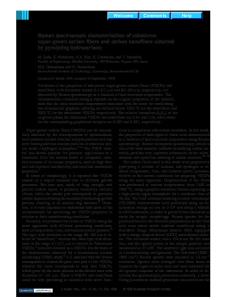Structural Characterization of Boron-doped Submicron Vapor-grown Carbon Fibers and Their Anode Performance
- PDF / 1,230,521 Bytes
- 11 Pages / 612 x 792 pts (letter) Page_size
- 34 Downloads / 336 Views
M.S. Dresselhaus Massachusetts Institute of Technology, Cambridge, Massachusetts 02139 (Received 29 September 1999; accepted 23 March 2000)
Structural evolution of undoped and boron-doped submicron vapor-grown carbon fibers (S-VGCFs) was monitored as a function of heat-treatment temperature (HTT). Based on x-ray and Raman data, over the range of HTT from 1800 to 2600 °C, it was found that boron atoms act as catalysts to promote graphitization due to boron’s higher diffusivity. For the range of HTT from 2600 to 2800 °C, the process of boron out-diffusion from the host material induces defects, such as tilt boundaries; this process would be related with the improved capacity and Coulombic efficiency of boron-doped S-VGCFs. When 10 wt% S-VGCFs was used as an additive to synthetic graphite, the cyclic efficiency of the capacities was improved to almost 100%.
I. INTRODUCTION
Vapor-grown carbon fibers (VGCFs) have been grown by the decomposition of hydrocarbons, such as benzene and methane, using transition metal particles as a catalyst at a growth temperature of 1000 to approximately 1300 °C.1–7 These fibers have been characterized in terms of the highly preferred orientation of their graphitic basal planes parallel to the fiber axis, with an annular ring texture in the cross section. This structure gives rise to excellent mechanical properties, very high electrical and thermal conductivity, and a high graphitizability of the fibers.4,5 Therefore, many researchers have tried in recent years to reach the final target of mass production. Among the various processing methods, the most important one has been the development of the floating reactant method,6–8 which allows a three-dimensional dispersion of the hydrocarbon together with the catalytic particles derived from the pyrolysis of organometallic compounds, such as ferrocene, in a reaction chamber, resulting in a high yield and a rather uniform diameter of the resulting fibers. Therefore, the floating reactant method is thought to be a promising means for the mass production of carbon fibers at relatively low cost. The fibers obtained by the floating reactant method in our laboratory have a narrow diameter distribution (from 0.1 to 0.2 m), showing almost the same morphology as compared to that of normal vapor-grown carbon fibers (VGCFs) (10 to approximately 20 m), which consist of a central filament and an external deposit of pyrolytic carbon with the ana)
Address all correspondence to this author. e-mail: [email protected] J. Mater. Res., Vol. 15, No. 6, June 2000
http://journals.cambridge.org
Downloaded: 30 Mar 2015
nular ring structure of a tree.4 Furthermore, these fibers have a high possibility for application as a filler in composites and as an anode material in lithium ion batteries, including additives to anode materials, due to their excellent conductivity and high surface-to-volume ratio. Since boron doping into carbon materials has been known to change the physical and chemical properties, there have been many in-depth studies of the
Data Loading...











